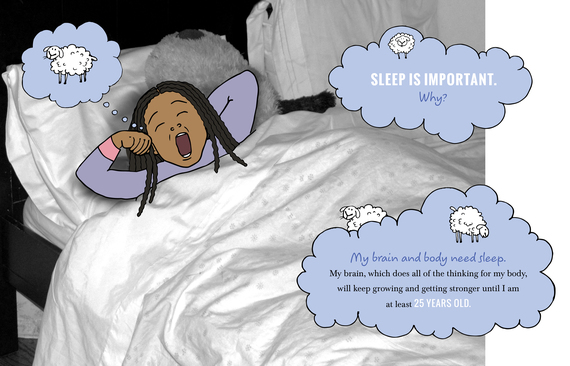“Just one more story, puleeeease?”
“I’m thirsty”
“Five more minutes!”
Bedtime is my most cherished and trying time of day. I love cuddling in a chair with my kids and reading that extra chapter. But the bedtime period is tough, not just because I’m exhausted, but because I know that creeping bedtimes directly impact the health and development of my growing children.
The research is overwhelming: Too little sleep causes serious problems for children. Childrens’ brains are developing and rewiring up until their mid-20s; research shows that this process continues longer than we’d previously thought.1 Studies suggest that every 15 minutes less sleep for high schoolers means a drop of one letter grade. 2 Yes, you read that correctly. Lack of sleep contributes to bad moods, sickness, depression, and even obesity. Need I go on?
Some simple tips based on the science of the brain can help get kids to bed, and help everyone stay asleep for the night. Reading to children about why sleep is so important and how to create a bedtime plan is the first step to improving everyone’s sleep. Children should not be underestimated in their ability to contribute meaningfully to the solution, once they understand the problem. Here are a few of the key points I help kids to understand in When It’s Time for Bed, I Have a Plan:
1) Create a bedtime plan TOGETHER
We can’t just give our children the bedtime plan. Bedtime is a time of separation for children, so you can help to comfort and empower them by making them a part of the plan. We all need to feel a sense of control over our lives, including children. With a plan prepared together, bedtime will be a more meaningful and productive family experience.
2) Start a good-night journal
For a few minutes each night before bedtime, writing or drawing about the day (even for pre-readers) is a great way to work through thoughts, clear the brain, and calm the body. In addition, writing or drawing about our problems, scary thoughts, or dreams can reduce nightmares for both children and adults. Journaling can be so effective because it uses both our left and right sides of the brain together to combine our logic and emotions. When we write and draw about our experiences, we make implicit memories explicit so we can make sense of our experiences, deal with them intentionally, and feel additional control over our lives. 3
3) Dim the lights and stay away from electronic devices
Dimming the lights before bedtime helps to prepare our brains for sleep. Room light and the artificial light emanating from electronic devices lower our melatonin levels and stimulate our brains, tricking our bodies into believing that we are not tired. 4Give your brain and your body a break by making a plan that eliminates television, computer, and other screen time at least 60 minutes before bedtime.
4) Play a short bedtime game
There are lots of short, quiet games that help us clear our minds as we lie in bed, getting ready for sleep. One favorite we have played since our kids were little is “Two Truths and a Fake.” We each take turns saying three things we did that day, only two of which were real. The rest of the family votes on which of the items was invented. This is an amusing game that encourages everyone in the family to share their experiences from the day, but it also serves the important purpose of encouraging our kids to think intentionally about their day, to process those events, and to help relax their brains for sleep.
5) Listen to a good-night talk or make your own
Mindfulness exercises, which focus on the present moment, teach lifelong relaxation skills and promote better sleep, including for children. A short, guided talk before bedtime that focuses on relaxation and deep breathing can help children fall asleep more easily and enjoy a better night’s rest. “Good Night, Dear Brain (yawn), Good Night,” is a first-of-its kind, three-minute audio talk, narrated by Jennifer Garner, that was specifically developed to help kids relax for sleep. Once children understand the concept, they can write their own chat and play it at bedtime. Our daughter recorded a two-minute talk to herself on my phone when she was five, about a scary ride she went on that gave her nightmares. She played this talk for herself every night for about six months, which eased her fears before bedtime. Taking time to focus on relaxation and breathing before bedtime produces miraculous results for children, and adults too.
6) Change scary thoughts into silly thoughts
It is important that we learn at a young age that we are the “boss of our brain.” Thinking productively and positively takes practice, but it is an invaluable skill to learn. One helpful exercise when kids are scared to go to bed or wake up fearful during the night is to teach them to take control of their imaginations by changing their scary thoughts into silly thoughts: Imagine that scary dragon with polka dots and sunglasses, or the monster on a floatie in a pool drinking from a swirly straw. The possibilities are endless!
7) Remember to hug a favorite stuffed animal
So simple but scientifically supported, when saying goodnight to a parent, substituting a stuffed animal to fall asleep really helps. A study of children who were scared at bedtime revealed that receiving a stuffed animal significantly reduced nighttime fears when compared to the group without a stuffed animal. 5
8) Follow the SAME PLAN with the SAME BEDTIME each night
Children thrive with a routine and a consistent bedtime. New research suggests that the consistency of childrens’ bedtimes, and not just the number of hours of sleep, is critical for developing brains. In a recent study, children with non-regular bedtimes had more behavioral problems. For children who changed from non-regular to regular bedtimes, behavior significantly improved. 6
A well-rested household is truly one of the best gifts you can give your family this holiday season. It starts with a consistent routine, developed with significant input from your kids, making bedtime a time to be cherished rather than feared, for both children and adults. You may just be surprised when you hear your child exclaiming one night: “Mommy, it’s time for bedtime!”

References
(1) David Dobbs, “Beautiful Brains,” National Geographic (Oct. 2011), at 43.
(2) Po Bronson, “Snooze or Loose,” New York (Oct. 2007) (analyzing sleep studies).
(3) Daniel J. Siegel & Tina Payne Bryson, “The Whole-Brain Child,” at 27-29.
(4) Wood et al., “Light level and duration of exposure determine the impact of self-luminous tablets on melatonin suppression” (Mar. 2013); Gooley et al., “Exposure to Room Light before Bedtime Suppresses Melatonin Onset and Shortens Melatonin Duration in Humans,” JCEM (Mar. 2011).
(5) Kushnir & Sadeh, “Assessment of brief interventions for nighttime fears in preschool children,” (Jan. 2012).
(6) Kelly, Kelly & Sacker, “Changes in Bedtime Schedules and Behavioral Difficulties in 7 Year Old Children,” Pediatrics (Aug. 2013).
Follow Katherine Eskovitz on Twitter: www.twitter.com/Blueprintlittle
